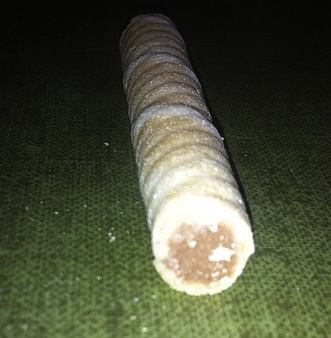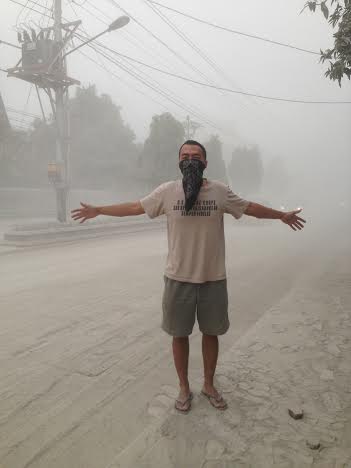 On February 14th Volcanocafe received the following email:
On February 14th Volcanocafe received the following email:
“My name is Mercuysimo, I live in Jogjakarta (approx. 200km from Kelud) right now. I’m interested in sending you some volcanic ash sample from Kelud eruption, because in Jogjakarta we suffer heavily of ashes rain (more than Merapi eruption we’ve experienced before). If these kind of sample still relevant to your sample needs. Please don’t hesitate to contact me. Thanks”
Attached were the following images taken on February 13th 2014 in the streets of Jogakarta.
07.30 WIB
Ash deposit material on the road after the rain stopped
As soon as the email arrived Chryphia got back to mercurysimo and asked him to send an ash sample to me at the museum Ars Electronica Center in Linz Austria. The sample arrived in my hands on tuesday and i started doing several microscopic images using the scopes in the BioLab. ( If you want to see which scopes are available there please check -> https://volcanocafe.wordpress.com/microscopic-images/ )
Late Tuesday evening i uploaded a gallery of Kelud ash images to VC: https://volcanocafe.wordpress.com/kelut/

Could not help myself and so i added a sneak preview in the comment thread announcing the complete gallery for later in the evening. This image is without the Copyright but whoever wants to use it, i beg you to ask me email: Spica308@gmail.com
Emails were sent back and forth, asking mercurismo where and when exactly he got a hold of the ashes. We also wondered if the ashes are different from Merapi ashes which sometimes rain down on Jogakarta. Here is his reply:
mercurysimo:
“The ashes from Kelud differences may be because of material contains or the distance between Merapi and Kelud are collected. I guess Merapi ashes felt rougher because sand or hard material rather than the ashes. This is the news which I refer to ( http://nasional.news.viva.co.id/news/read/483805-abu-vulkanik-kelud-bisa-dijadikan-campuran-adonan-semen), but It has been written in local language (Bahasa Indonesia).
Chronologically, almost midnight at 13th February 2014 several people heard the explosions, but most of us didn’t realize that sound come from the eruption. In the morning, at 14th February 2014 maybe around 4a.m. (but I’m not sure) it started to having ashes rain but only a little, my neighbor who woke up earlier than me just told that. Around 6a.m we found the sky turned to red, because the sun light cannot emit rays through the ashes that still on the air. The ashes rain showered more dense approx until 8a.m, and it still wend down until afternoon. In the morning, people stayed still in their home, but around 10a.m only few people went out but only a little seemed to be panic. It may be Jogjakarta citizen had experience before. At 3p.m in the same day, after the material totally stopped falling, I collected the sample and have been keeping it in dry and air sealed container. The thickness of the ashes are about 1-2cm, and it layered entire city on average. I think that I have ever attached some pics to this email address, would you please checked on my earlier mail. Success for your story! Thanks for asking anyway.
mercurysimo ”
Giggle translates the article as follows:
 “Headline – Volcanic ash from the eruption were carried by the wind and spread quite harmless, especially for soil and plants.Volcanic ash was in fact also have a positive impact and benefits on the other side.
“Headline – Volcanic ash from the eruption were carried by the wind and spread quite harmless, especially for soil and plants.Volcanic ash was in fact also have a positive impact and benefits on the other side.More images from the Kelut microscopic image gallery:
The magnification in this image is “only” 630 fold to provide the possibility to check the size of the grains and show that there were very few “bubbles” to be seen, which means the material had obviously been degassing before it erupted.
Zoomed in into one of the whitish particles in the earlier image. Please not that a SEM image does not show the original color of a sample. What is shown as white is a material which is more dense than the grayish particles and reflected the ray of electrons better than the surrounding material.
One of the few particles which showed “bubbles”.
Higher magnifications of the part of the sample to be found in the gallery.
Transmitted Ligh Microscope image.
Reflected light microscope image. Using the reflected light microscope did not really make much sense because the ash clumped together and all which one could determine was a layer of beige material with brown speckles.

The “nail” in the center reminds me of my mates favorite cookies called Haselnussröllchen.
SPICA
Riddles
This week’s riddles turned out to be a tad equivoque, but I think all of you are of legal age. Last week a feverish Kelda stepped up to the challenge and wrangled out a stable second position. As usual there is one volcanologist, one volcanic term and 3 volcanoes hiding among the riddly brainwrecks. Good luck to all!
- Geothermal divided + image (Clue, concentrate on the actual cat, and what part of the world is divided, there is a geothermal field at this cat, hard to come up with more clues for a volcano-cat) – Paka, Great Rift Valley, Kenya (No correct answer, 1 bonuspoint to Diana Barnes)
- Mary in the village had a crater swimming butt (Clue, it should be spelt Mary in the village Butte, crater lake will lead to the answer, “Petrography”) – Howel Williams (Spica, 1pt). He wrote the books GEOLOGY OF THE MARYSVILLE BUTTES CALIFORNIA and PETROGRAPHY, he also worked extensively with Crater Lake.
- Far from musical staggered arrangement – Echelon (Kelda, 2pt). Set of geologic features that are in an overlapping or a staggered arrangement
- Here be lingering kisses and shrines (Clue, think about a slang word for long kisses, no 52, vowely long names, Island) – Necker Island, Hawai’i (No point awarded)
- By water’s edge this famous car perished (Clue, think US car) – Soufrére Hills, Plymouth, Montserrat (Bobbi & Dinojura44, 1pt each).
| Score board | ||
| 20 Sissel 15 Kelda 10 Cryphia 10 Dinojura44 10 Evan Chugg 7 Dorkviking 4 Edward |
4 Matt 4 Pyter 3 GeoLurking 3 Spica 2 Alison 2 Inannamoon |
2 Lughduniense 2 UKViggen 1 Bobbi 1 DFM 1 KarenZ 1 Sa’Ke |
SPICA (Text and Images) & CARL (Evil Rddler)

















Dr Peter Webleys second part on remote sensing volcanoes is now published!
https://volcanocafe.wordpress.com/2014/03/24/remote-sensing-of-real-time-volcanic-activity-part-2-spaceborne-sensors/
Watching those earthquakes around Skaftafell has me a bit concerned. Oreafajokull might be one of those spots that needs more monitoring.